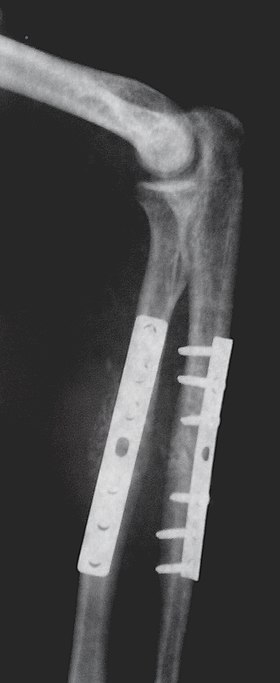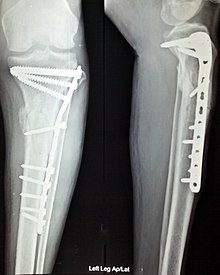Internal fixation
| Internal fixation | |
|---|---|
 | |
| ICD-9-CM | 78.5 |
| MeSH | D005593 |
Internal fixation is an operation in orthopedics that involves the surgical implementation of implants for the purpose of repairing a bone, a concept that dates to the mid-nineteenth century and was made applicable for routine treatment in the mid-twentieth century.[1][page needed] An internal fixator may be made of stainless steel, titanium alloy,[2] or cobalt-chrome alloy.[3] or plastics.
Types of internal fixators include:
Open reduction
[edit]
Open Reduction Internal Fixation (ORIF) involves the implementation of implants to guide the healing process of a bone, as well as the open reduction, or setting, of the bone. Open reduction refers to open surgery to set bones, as is necessary for some fractures. Internal fixation refers to fixation of screws and/or plates, intramedullary rods and other devices to enable or facilitate healing. Rigid fixation prevents micro-motion across lines of fracture to enable healing and prevent infection, which happens when implants such as plates (e.g. dynamic compression plate) are used. ORIF techniques often are used in cases involving serious fractures such as comminuted or displaced fractures or, in cases where the bone otherwise would not heal correctly with casting or splinting alone.
Risks and complications may include bacterial colonization of the bone, infection, stiffness and loss of range of motion, non-union, mal-union, damage to the muscles, nerve damage and palsy, arthritis, tendonitis, chronic pain associated with plates, screws, and pins, compartment syndrome, deformity, audible popping and snapping, and possible future surgeries to remove the hardware.
Closed reduction
[edit]

Closed Reduction Internal Fixation (CRIF) is reduction without any open surgery, followed by internal fixation. It appears to be an acceptable alternative in unstable distressed lateral condylar fractures of the humerus in children, but if fracture displacement after closed reduction exceeds 2 mm, open reduction and internal fixation is recommended.[4]
Various techniques of minimally invasive surgery for internal fixation of bones have been reported. The treatment of fractures of the distal third of the tibia has evolved with the development of improved imaging and surgical techniques.[5]
Internal fixation implants for intracapsular hip fractures in older adults
The latest evidence suggests that there may be little or no difference between screws and fixed angle plates as internal fixation implants for intracapsular hip fractures in older adults.[6] The findings are based on low quality evidence that cannot firmly conclude major difference in hip function, quality of life, and additional surgery.[citation needed]
Additional images
[edit]

See also
[edit]- Arbeitsgemeinschaft für Osteosynthesefragen
- CNT Network Bio-stress Sensors
- External fixation
- Bone fracture
- Trauma surgery
- List of orthopedic implants
- Osseoincorporation
- Osseointegration
References
[edit]- ^ Schlich T (2002). Surgery, Science and Industry. A Revolution in Fracture Care, 1950s-1990s. Houndsmills, Basingstoke: Palgrave.
- ^ General Principles of Internal Fixation at eMedicine
- ^ "BioDur®CCM® Alloy". Carpenter. Retrieved 8 May 2019.
- ^ Song KS, Kang CH, Min BW, Bae KC, Cho CH, Lee JH (December 2008). "Closed reduction and internal fixation of displaced unstable lateral condylar fractures of the humerus in children". The Journal of Bone and Joint Surgery. American Volume. 90 (12): 2673–81. doi:10.2106/JBJS.G.01227. PMID 19047713.
- ^ Krettek C (1997). "Foreword: concepts of minimally invasive plate osteosynthesis". Injury. 28 Suppl 1: A1-2. doi:10.1016/S0020-1383(97)90108-X. PMID 10897280.
- ^ Lewis SR, Macey R, Eardley WG, Dixon JR, Cook J, Griffin XL (March 2021). "Internal fixation implants for intracapsular hip fractures in older adults". The Cochrane Database of Systematic Reviews. 2021 (3): CD013409. doi:10.1002/14651858.cd013409.pub2. PMC 8092427. PMID 33687067.
External links
[edit]Procedures involving bones and joints | |||||||||||
|---|---|---|---|---|---|---|---|---|---|---|---|
| Bones |
| ||||||||||
| Cartilage | |||||||||||
| Joints |
| ||||||||||
Text is available under the CC BY-SA 4.0 license; additional terms may apply.
Images, videos and audio are available under their respective licenses.
